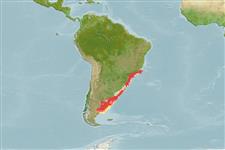Actinopterygii (ray-finned fishes) >
Ophidiiformes (Cusk eels) >
Ophidiidae (Cusk-eels) > Ophidiinae
Etymology: Raneya: Because of Edward C. Raney, 1909-1984. He was a leader amongst ichthyology, expert in fishes from eastern USA.
Environment / Climate / Range
Ecology
Marine; demersal; depth range 40 - 150 m (Ref. 27363). Subtropical, preferred ?; 22°S - 48°S, -69°W - -36°W
Southwest Atlantic: near Ilha Rasa, southern Brazil to Puerto Quequén, northern Argentina.
Size / Weight / Age
Maturity: Lm ? range ? - ? cm
Max length : 31.0 cm TL male/unsexed; (Ref. 9358)
Short description
Morphology | Morphometrics
Dorsal
spines
(total): 0;
Dorsal
soft rays
(total): 111-135;
Anal
spines: 0;
Anal
soft rays: 93 - 105;
Vertebrae: 62 - 66. Scales on body in regular but non-overlapping rows, some anguilloid, becoming anguilloid in pattern on belly and flanks in front of anus, top of head from interorbit to nape and sides of head with non-imbricate scales, snout, subocular area and chin and throat naked; ethmoid spine short but strong; gill chamber dark; esophagus dark and intestines and stomach pale; no pyloric caeca; males with posterior opening on swim bladder (Ref. 34024). About 10 broad dark brown bands on body. Dorsal, anal and caudal fin margins blackish. Caudal fin small, posterior margin rounded. Pelvic fins comprising two filamentous rays (Ref. 27363).
Uncommon species found in coastal waters (Ref. 34024). Oviparous, with oval pelagic eggs floating in a gelatinous mass (Ref. 205).
Life cycle and mating behavior
Maturity | Reproduction | Spawning | Eggs | Fecundity | Larvae
Nielsen, J.G., D.M. Cohen, D.F. Markle and C.R. Robins, 1999. Ophidiiform fishes of the world (Order Ophidiiformes). An annotated and illustrated catalogue of pearlfishes, cusk-eels, brotulas and other ophidiiform fishes known to date. FAO Fish. Synop. 125(18):178p. Rome: FAO. (Ref. 34024)
IUCN Red List Status (Ref. 115185)
CITES (Ref. 94142)
Not Evaluated
Threat to humans
Harmless
Human uses
Fisheries: minor commercial
More information
Age/SizeGrowthLength-weightLength-lengthLength-frequenciesMorphometricsMorphologyLarvaeLarval dynamicsRecruitmentAbundance
ReferencesAquacultureAquaculture profileStrainsGeneticsAllele frequenciesHeritabilityDiseasesProcessingMass conversion
Tools
Special reports
Download XML
Internet sources
Estimates of some properties based on models
Phylogenetic diversity index (Ref.
82805): PD
50 = 1.0000 [Uniqueness, from 0.5 = low to 2.0 = high].
Bayesian length-weight: a=0.00269 (0.00171 - 0.00425), b=3.21 (3.08 - 3.34), in cm Total Length, based on LWR estimates for this species & (Sub)family-body (Ref.
93245).
Trophic Level (Ref.
69278): 3.6 ±0.7 se; Based on size and trophs of closest relatives
Resilience (Ref.
69278): High, minimum population doubling time less than 15 months (Preliminary K or Fecundity.).
Vulnerability (Ref.
59153): Low to moderate vulnerability (29 of 100) .
